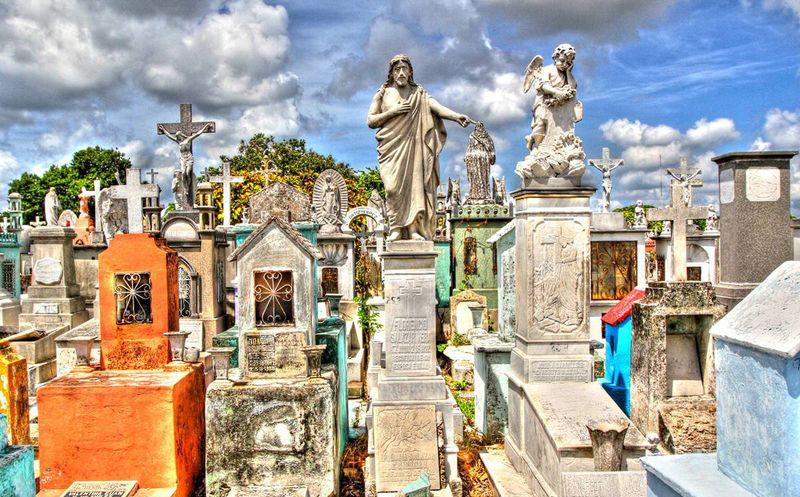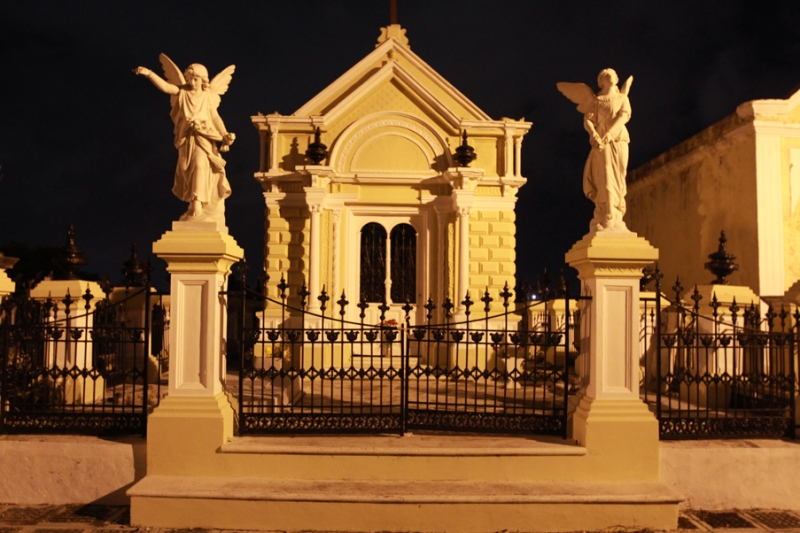There are 25,700 vaults, ossuaries and mausoleums in the 150,000 square meters that house the general cemetery of Mérida….
MERIDA – The final residence of the people of Merida, its General Cemetery, has a long history that starts in 1821, when it was inaugurated. Then it was given to the ecclesiastical government to administrate it, with the condition that each month they will pay to the state a specific tariff to cover the investment made in its construction.
In 1859 President Benito Juárez nationalized the church’s assets, including the general cemetery, which passed to be administered by the state government, specifically by the civil registry.
Wilberth Sosa, who is in charge of guiding visitors by the most emblematic sites of the General Cemetery of Merida, noted that in 1879 the large facade of the convent of San Francisco was placed at the entrance of the cemetery, but now it can’t be appreciated any more, since in 1980 it was given another style.
“In 1910, there is a need to acquire the lands on the east side for expansion, where the seismological building is placed, which is now managed by the UNAM and the Uady, through the Hideyo Noguchi Research Center,” he said.
In 1928 two twin buildings were built on the west side, the first serving as administrative offices and the second as a morgue. In 1981 a cold room for the conservation of corpses was attached to it, and in 1982, due to the state in which the administrative building was, it had to be destroyed.
He also said that the general cemetery had its greatest splendor in the late nineteenth and early twentieth century, when its main avenue can be compared to Paseo de Montejo, because many wealthy families wanted their mausoleums to be placed on the avenue.
Sosa explained that at that time there was a custom that when a corpse arrived they had to build their place as similar to the place where they lived, so that the deceased did not feel alone. That is why most of the mausoleums of the General cemetery have different architectural styles, with materials brought from Europe.
“According to the administrative books, the oldest of the mausoleums dates from 1870, retains its original style and belongs to the Medina Rodriguez family; the owner lived in what is now the Pan American Hotel, which is located on 59th Street by 52nd and 54th of the Historic Center. In the General Cemetery there are more than 120 mausoleums, which vary in their vaults. Also it has 2,000 ossuaries, which are places destined for the deposit of ashes or dry remains,” he said.
He explained that the pantheon has three types of mausoleums: the open, which is the one that does not have a chapel; the closed, which has a chapel in where burials are made, and the mixed mausoleum, which is where burials are made inside and outside them. An example is the mausoleum of the clergy, who depending on the rank of the priest were buried inside or outside the mausoleum.
There is also the mausoleum of Cumulus type, which is characterized by having the base of a huge coffin, followed by a monument, and which at the top culminated with a sculpture. This type of mausoleum houses important personages like General Guillermo Palomino, who was governor of Yucatan in 1885, noted for expanding the avenue of Mérida and the railroad branches so that distant populations had better communication with the capital, he said.
In the same way, said Wilberth Sosa, on the avenue you can see vaults cemented to each other, and some of them stand out because they have angels of silence, with a finger in the mouth and another pointing the sky in a sign of respect. There are also the angels of pain, which are accompanied by a cross and where pain is reflected in his face.
Source: laverdadnoticias.com
To check the rest of the “Dia de Muertos” series click on the tag “Dia de Muertos” or on the following links:
- www.theyucatantimes.com/dia-de-muertos-all-saints-day-two-schools-of-thought-blend-into-one-tradition/
- www.theyucatantimes.com/hanal-pixan-the-yucatecan-dia-de-muertos-the-altar-is-the-heart-of-the-festivity/
- www.theyucatantimes.com/the-four-most-haunted-places-in-yucatan/
- www.theyucatantimes.com/dia-de-muertos-a-celebration-of-life/
- www.theyucatantimes.com/la-catrina-mexican-representation-of-death/
- www.theyucatantimes.com/the-paseo-de-las-animas-meridas-new-tradition/
- www.theyucatantimes.com/pan-de-muerto-the-sweet-part-of-the-dia-de-muertos-festivity/
- www.theyucatantimes.com/tyt-infographic-dia-de-muertos/










